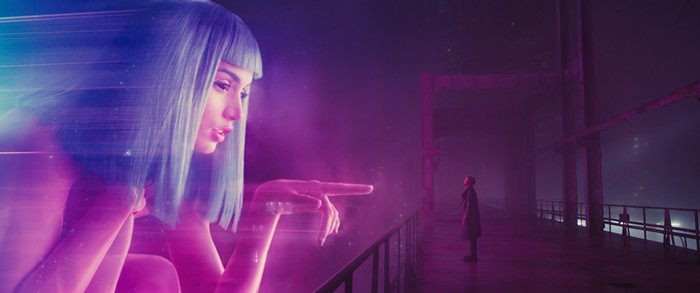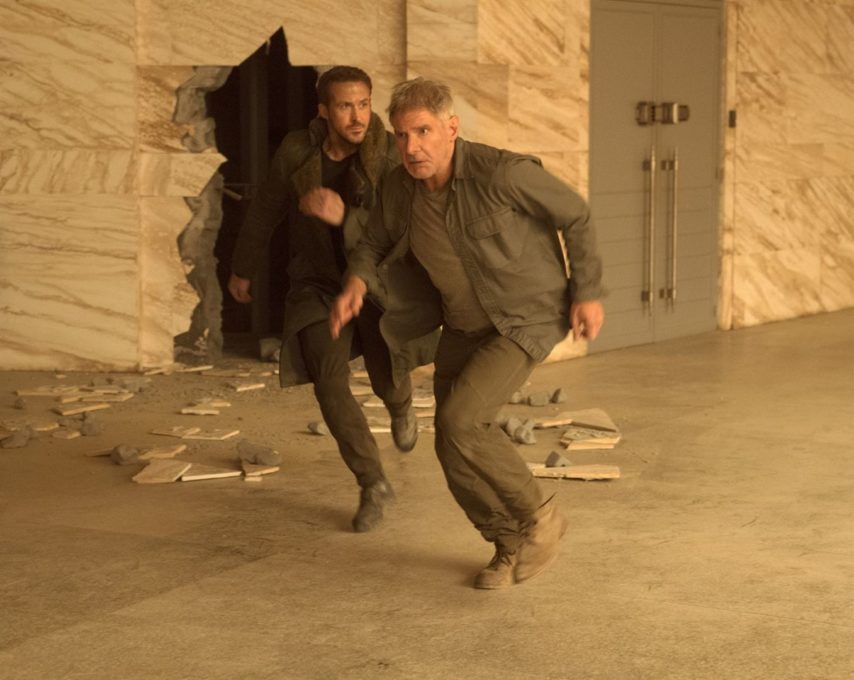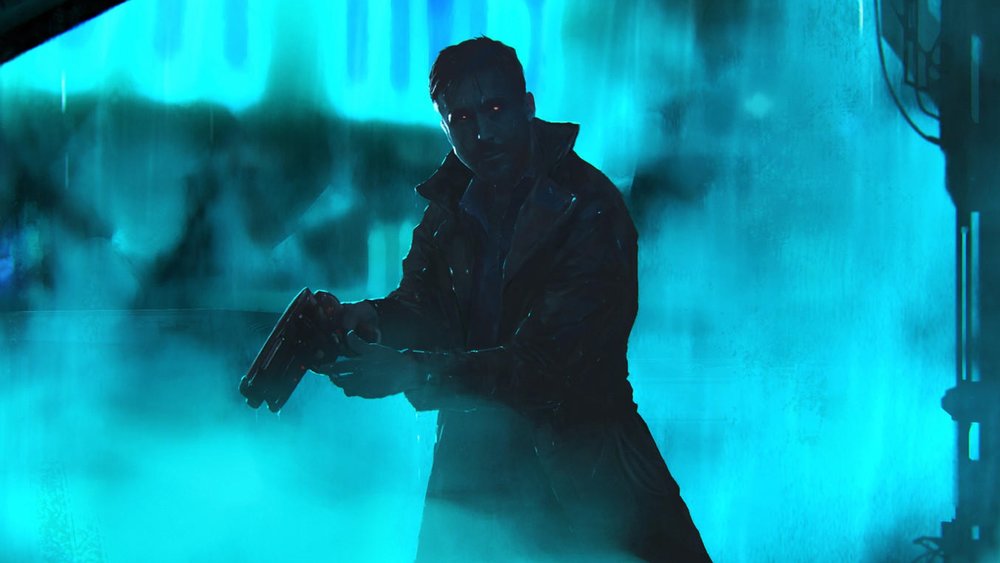Blade Runner 2049 (2017)
CAST: Ryan Gosling, Harrison Ford, Robin Wright, Ana de Armas, Sylvia Hoeks, Jared Leto, Dave Bautista
REVIEW:
WARNING: WHILE THIS REVIEW ATTEMPTS TO AVOID MAJOR “SPOILERS”, IT WILL REVEAL ASPECTS OF THE FILM’S PLOT
Thirty-five years ago, Ridley Scott directed Blade Runner, which while receiving mostly negative critical reviews and failing to make back its budget at the box office (Harrison Ford fans likely expected something more action-oriented than what was on display), gained a cult following and is held up today as a visionary sci-fi classic. In the intervening decades, Scott has occasionally returned to the Blade Runner universe with a 1992 director’s cut and a 2007 “final cut”, while speculation about a follow-up percolated, which has finally been brought to the screen by Denis Villeneuve (Sicario, Prisoners, Arrival), who took over directorial duties when Scott stepped down due to scheduling conflicts with Alien: Covenant (although he remains credited as producer). While perhaps slightly less obtuse, Blade Runner 2049 maintains the tone and pacing of its forefather (which, depending on who you ask, might be a good or bad thing) and is a close cousin. To those for whom the original Blade Runner is not their cup of tea, 2049 seems unlikely to convert them, but those with high regard for Scott’s 1982 film may find much to appreciate about this long-awaited return to its dark world.
It has been thirty years since the events of the 1982 film (which was set in the then-futuristic 2019). In the meantime, after the violent rebellion of replicants (superhumanly strong artificial beings created for slave labor) in the first movie, replicants were banned and their creator Tyrell Corp went bankrupt. In the intervening years, an economic crash led to the rise of ambitious entrepreneur and inventor Niander Wallace (Jared Leto), who took over the remnants of Tyrell Corp and produced a new line of obedient replicants. The last remaining survivors of the banned older generation are fugitives living underground, still being hunted down and eliminated by cops known as blade runners. One of these is “K” (Ryan Gosling), who gets in over his head when a seemingly routine mission to “retire” an older replicant (Dave Bautista) leads him down a rabbit hole when he stumbles across a deeply-buried secret about replicants. This investigation ultimately leads him to long-missing former blade runner Rick Deckard (Harrison Ford) and makes both of them targets of Wallace’s henchwoman Luv (Sylvia Hoeks).
 One could argue the most impressive thing about Blade Runner was its production design, and 2049 follows suit. Despite the decades between the two films, its Los Angeles looks almost identical to the one Ridley Scott designed in 1982 (except perhaps even more dilapidated), and it’s clear that Villeneuve (an avowed Blade Runner devotee) put a great deal of detail and effort into closely replicating the original film’s distinctive style and ensuring it looks like Blade Runner. Like the original, much of 2049 takes place in darkness and rain. Hans Zimmer frequently pays homage to the original synth score by Vangelis. Wallace’s gold-drenched, half-lit headquarters recall that of Dr. Tyrell in the original film, and there’s an eerie corridor lined by half-formed replicants floating in glass display cases, like a macabre museum. There are striking visuals, including huge holographic advertisements and an enormous holographic ballerina dancing in a city street, K’s venture into the sand-blasted, nuked remains of an uninhabited Las Vegas, and a fistfight among intermittently flickering holographic stage performers in an abandoned nightclub (including Elvis).
One could argue the most impressive thing about Blade Runner was its production design, and 2049 follows suit. Despite the decades between the two films, its Los Angeles looks almost identical to the one Ridley Scott designed in 1982 (except perhaps even more dilapidated), and it’s clear that Villeneuve (an avowed Blade Runner devotee) put a great deal of detail and effort into closely replicating the original film’s distinctive style and ensuring it looks like Blade Runner. Like the original, much of 2049 takes place in darkness and rain. Hans Zimmer frequently pays homage to the original synth score by Vangelis. Wallace’s gold-drenched, half-lit headquarters recall that of Dr. Tyrell in the original film, and there’s an eerie corridor lined by half-formed replicants floating in glass display cases, like a macabre museum. There are striking visuals, including huge holographic advertisements and an enormous holographic ballerina dancing in a city street, K’s venture into the sand-blasted, nuked remains of an uninhabited Las Vegas, and a fistfight among intermittently flickering holographic stage performers in an abandoned nightclub (including Elvis).
Anyone who goes into Blade Runner 2049 expecting an action-packed sci-fi thriller may be disappointed. There are brief bursts of action, including an opening brutal hand-to-hand fight between Ryan Gosling and Dave Bautista, and later a fistfight between K and Deckard, a raid on Deckard’s safe house, and a climactic fight with Wallace’s henchwoman Luv, but this isn’t an action movie. The pace is perhaps not quite as sluggish as the original, but it’s slow and elegaic and the nearly three hour runtime is formidable. The few and far between action sequences are just secondary elements to spice things up. The main narrative framework is that of an investigative detective mystery, but ultimately as in the original, the overriding core theme is the weighty question of what it means to be human. The relationship between K and his AI girlfriend Joi echoes the one between Joaquin Phoenix and his Siri-esque “companion” voiced by Scarlett Johansson in Her, and raises some questions about the line between AI and sentience and questions of a soul. Is Joi merely acting out her programming to be a devoted companion to K, or is she truly capable of feeling for him? The movie raises the question but doesn’t provide a black-and-white answer, and some scenes could be interpreted in different ways by different viewers. Likewise, K himself undergoes a character arc of finding there might be more to him than just robotic obedience.
 This marks the latest in Harrison Ford’s “greatest hits” reprisals of some of his best-known characters (Indiana Jones, Han Solo, and now Rick Deckard), but while Ford’s involvement is a major selling point, his role is firmly a supporting one and he doesn’t show up until two-thirds of the way into the movie, with Ryan Gosling’s K as the main protagonist. The weight of the decades and key losses have taken their toll on this grizzled, gravelly-voiced Deckard (though ironically he feels more “human” here than he did in 1982), but his screentime is a fraction of Gosling’s. Deckard is back, but in a smaller, more limited role than Indiana Jones, or Han Solo in The Force Awakens. Those who hope for a definitive answer to the age-old “is he or isnt he?” question of Deckard’s humanity may be frustrated to learn Villeneuve has chosen to leave it ambiguous (for the record, Ridley Scott himself has stated he intended Deckard to be a replicant, though Harrison Ford is not onboard with this interpretation). As for Ryan Gosling’s K, there is no ambiguity. He is a replicant and knows it, part of Wallace’s new obedient generation (this doesn’t really count as much of a spoiler, considering it’s revealed within the first few minutes). K is cut from a little of the same cloth as Deckard was in the first movie, a dour hangdog noir-ish detective, except K has a live-in girlfriend (of sorts), a holographic AI called Joi (Ana de Armas), whom he dotes on (he even gifts her an “emanator”, a handheld projector that allows her to accompany him anywhere he goes instead of being confined to his apartment). Like the younger Deckard, K does not enjoy his unsavory job but is resigned to his lot in life, at least until the revelations he stumbles across cause inner conflict and the “obedient” replicant might not prove quite so obedient after all. Gosling slips easily into the role of the noir-ish detective, cutting a broody figure in trenchcoat through murky streets, as well as conveying deeper feelings beneath K’s impassive demeanor. The supporting cast includes Cuban actress Ana de Armas as K’s beguiling holographic “girlfriend” Joi, Robin Wright (looking even more stern and hard-faced than as General Antiope in Wonder Woman) as his chilly boss, and a small opening role for Dave Bautista. Jared Leto is creepy as the replacement Tyrell, Wallace, but only appears in two key scenes. Sylvia Hoeks as his steely replicant henchwoman Luv gets substantially more screentime and is arguably the movie’s real primary villain; the Dutch actress isn’t likely to be familiar to most American moviegoers, but she makes an icy impression. There are small roles for Mackenzie Davis, David Dastmalchian, Barkhad Abdi (the pirate leader in Captain Phillips) and The Walking Dead‘s Lennie James, and a cameo from the original film’s Edward James Olmos. Another original cast member, Sean Young’s Rachael, makes a cameo, of sorts, via a combination of CGI and body double recreating Young as she appeared in the 1982 film. This kind of special effect is showing up in more and more movies lately (Michael Douglas, Arnold Schwarzenegger, Robert Downey Jr., and Kurt Russell digitally de-aged to their 1980s selves in Ant-Man, Terminator: Genisys, Captain America: Civil War, and Guardians of the Galaxy Vol. 2, respectively, and last year’s Rogue One giving us a resurrected Peter Cushing and a circa 1977 Princess Leia). These recreations of actors’ physical appearances from decades ago can be hit-or-miss, but Rachael is virtually indistinguishable from her original 1982 self. While the real 2017 Sean Young is not, strictly speaking, in the movie, she apparently acted out the scene to provide a basis for the younger Rachael’s facial expressions, and is listed in the end credits.
This marks the latest in Harrison Ford’s “greatest hits” reprisals of some of his best-known characters (Indiana Jones, Han Solo, and now Rick Deckard), but while Ford’s involvement is a major selling point, his role is firmly a supporting one and he doesn’t show up until two-thirds of the way into the movie, with Ryan Gosling’s K as the main protagonist. The weight of the decades and key losses have taken their toll on this grizzled, gravelly-voiced Deckard (though ironically he feels more “human” here than he did in 1982), but his screentime is a fraction of Gosling’s. Deckard is back, but in a smaller, more limited role than Indiana Jones, or Han Solo in The Force Awakens. Those who hope for a definitive answer to the age-old “is he or isnt he?” question of Deckard’s humanity may be frustrated to learn Villeneuve has chosen to leave it ambiguous (for the record, Ridley Scott himself has stated he intended Deckard to be a replicant, though Harrison Ford is not onboard with this interpretation). As for Ryan Gosling’s K, there is no ambiguity. He is a replicant and knows it, part of Wallace’s new obedient generation (this doesn’t really count as much of a spoiler, considering it’s revealed within the first few minutes). K is cut from a little of the same cloth as Deckard was in the first movie, a dour hangdog noir-ish detective, except K has a live-in girlfriend (of sorts), a holographic AI called Joi (Ana de Armas), whom he dotes on (he even gifts her an “emanator”, a handheld projector that allows her to accompany him anywhere he goes instead of being confined to his apartment). Like the younger Deckard, K does not enjoy his unsavory job but is resigned to his lot in life, at least until the revelations he stumbles across cause inner conflict and the “obedient” replicant might not prove quite so obedient after all. Gosling slips easily into the role of the noir-ish detective, cutting a broody figure in trenchcoat through murky streets, as well as conveying deeper feelings beneath K’s impassive demeanor. The supporting cast includes Cuban actress Ana de Armas as K’s beguiling holographic “girlfriend” Joi, Robin Wright (looking even more stern and hard-faced than as General Antiope in Wonder Woman) as his chilly boss, and a small opening role for Dave Bautista. Jared Leto is creepy as the replacement Tyrell, Wallace, but only appears in two key scenes. Sylvia Hoeks as his steely replicant henchwoman Luv gets substantially more screentime and is arguably the movie’s real primary villain; the Dutch actress isn’t likely to be familiar to most American moviegoers, but she makes an icy impression. There are small roles for Mackenzie Davis, David Dastmalchian, Barkhad Abdi (the pirate leader in Captain Phillips) and The Walking Dead‘s Lennie James, and a cameo from the original film’s Edward James Olmos. Another original cast member, Sean Young’s Rachael, makes a cameo, of sorts, via a combination of CGI and body double recreating Young as she appeared in the 1982 film. This kind of special effect is showing up in more and more movies lately (Michael Douglas, Arnold Schwarzenegger, Robert Downey Jr., and Kurt Russell digitally de-aged to their 1980s selves in Ant-Man, Terminator: Genisys, Captain America: Civil War, and Guardians of the Galaxy Vol. 2, respectively, and last year’s Rogue One giving us a resurrected Peter Cushing and a circa 1977 Princess Leia). These recreations of actors’ physical appearances from decades ago can be hit-or-miss, but Rachael is virtually indistinguishable from her original 1982 self. While the real 2017 Sean Young is not, strictly speaking, in the movie, she apparently acted out the scene to provide a basis for the younger Rachael’s facial expressions, and is listed in the end credits.
At the bottom line, whether Blade Runner is your cup of tea is a good barometer for whether you’ll enjoy Blade Runner 2049. Its nearly three hour runtime is challenging, and at times K’s drawn-out, meandering investigation strains attention. But it’s visually striking and thought-provoking with weighty existential questions, and Villeneuve has managed the task of creating a sequel to a 35-year-old film that feels faithful to its forebearer in appearance, mood, style, and underlying thematic content.
* * *
